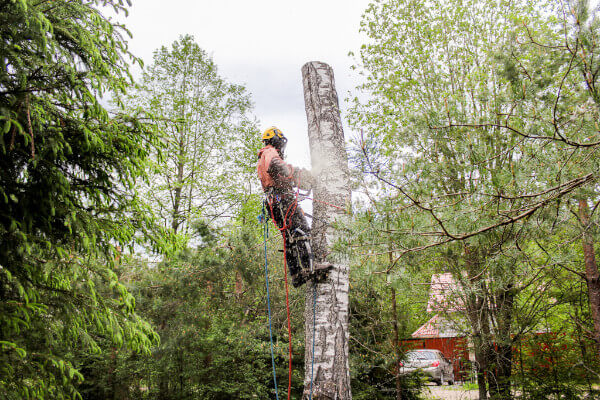
Tree Pollarding 101 – everything you need to know about pollarding.
If you are looking for ways to keep your landscape and trees looking their best, several key methods can make a huge impact on how your outdoor space looks.
A process called tree pollarding can help to create a lush, beautiful landscape that promotes healthy trees.
Read on to learn more about pollarding trees and what the process entails.
Tree Pollarding Defined
Most people likely have never heard of tree pollarding, but it is an important part of maintaining healthy trees. The process involves cutting young trees and shrubs to the main stem or trunk to control their height.
The plants are not cut at ground level but instead are cut much higher at an average height of around six feet. This process helps to maintain the desired height for your trees while reducing shade and giving the trees a defined silhouette.
Many people opt for tree pollarding to keep taller trees from getting in the way of phone lines or electrical wires. It is also done to trees located close to a home or place of business to reduce the risk of branches breaking and falling onto the roof.
While most typical tree pruning processes remove the lower and crossing limbs of a tree, the pollarding process is a bit different. Pollarding trees is often done when the tree is dormant rather than when it is actively growing. Doing this while a tree is still young or dormant promotes fuller, faster, and greener growth.
In addition to protecting wires, structures, and promoting better growth, tree pollarding may also reduce the risk of fungus and pests. It can also help to protect your trees from various diseases.
How to Pollard a Tree
To pollard a tree effectively, it is best to leave the job to the professionals. They will start by cutting off the central leader of the tree first, then proceed to cut all of the branches around it that are at the same height.
By cutting the top of the tree this way, it shortens the crown of the tree. The gardener will remove lower limbs and any crossing limbs to promote a thicker crown as it grows back.
The younger the tree, the faster the new growth will return, while older trees may take longer to regrow leaves and new branches. By pollarding large young deciduous trees, ensures that they sprout healthily to achieve fuller, greener, and lusher growth.
Once the procedure is complete, most trees will produce “waterspouts” at the various locations where it has been cut. These areas will produce sprouts that should be removed at least once per year or every other year. Eventually, knobs or knuckles will form at these locations and continue to regenerate each year.
The timing of tree pollarding is critical and should be performed during the tree’s dormant season. If the tree is pruned during its growing season, it can stunt the growth, remove its energy source, and inhibit the tree’s ability to re-sprout.
Most tree pollarding is done during the fall or winter months of the year when trees are losing their foliage. This is extremely important because most trees rely on their leaves to help produce energy for healthy growth during the warmer months of spring and summer. Removing sprouts and pollarding too early in the year can cause the tree to stop growing, or even worse – to perish.
Tradition of Pollarding Trees
Tree pollarding originated in Europe centuries ago, and the original method was done to ensure that more abundant, smaller branches were produced. As a result, these smaller branches were removed and used as fuel or for making items such as woven baskets.
As the branches were consistently cut back, farmers would harvest the slender sprouts and use them as a food source for livestock. These slender sprouts were also utilized to help weave small fences and other structures.
Today, pollarding fruit trees is a popular method to ensure healthy growth. When the tree is pollarded correctly, it encourages more production of fruits for a bountiful harvest.
Many urban areas choose to pollard trees that line busy streets to help control their growth, preventing branches from falling onto power lines and roadways. Cutting trees back can keep them healthy while maintaining them at a smaller, more easily manageable size.
The difference between topping and pollarding trees is that tree pollarding produces large knuckles. These knuckles are the source of new growth each year and can help to ensure that the tree continues to grow healthy in the future. Imagine the knuckles on a tree as large scars that heal while new growth re-sprouts from dormant buds during the springtime.
Topping a tree does not lead to knuckle formation. This process cuts the entire top of the tree off, resulting in a large wound that can cause the tree to die. Ideally, pollarding fruit trees and other species is best to ensure a healthy outcome.
Pollarding: A Unique Technique
Whether you want to encourage healthy growth or remove threatening branches, tree pollarding is a wise way to go. This unique tree-pruning process will ensure that your trees look lush and beautiful for years to come.
Always consult with a professional arborist or landscaper if you are considering using tree pollarding as a method to ensure best results.
For more information about our services or to find out more, contact us today.
Article was written by Conner D.
Article Source: https://www.graftingardeners.co.uk/tree-pollarding-101/